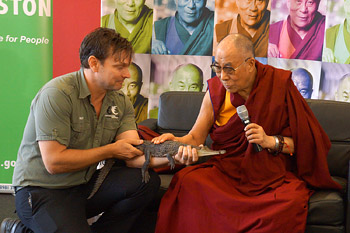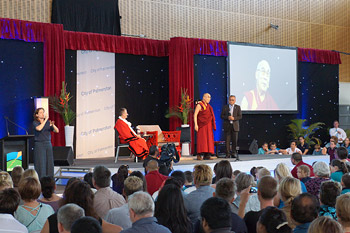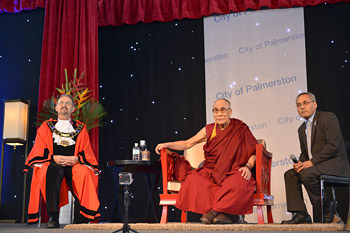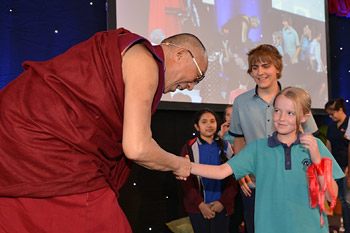Darwin, Australia, 22 June 2013 - It was still raining and the sky was overcast as His Holiness the Dalai Lama left his Adelaide hotel this morning. However, at the airport there were long lines of beaming-faced friends and well-wishers who had come to see him off. During the flight to Darwin, the pilot announced that he had obtained permission to take the plane over Uluru, also known as Ayers Rock. The sandstone outcrop sacred to the Anangu, the Aboriginal people of the area, is also listed as a UNESCO World Heritage Site.
Directly after landing at Darwin, His Holiness drove to the nearby satellite town of Palmerston where he was to meet the press and give a public talk. He began the press meeting by introducing himself:
“I am very happy to be here for the first time. Wherever I go I talk to people about the need to be aware of the oneness of humanity. In this context, my first commitment is promoting those human values that really contribute to human happiness. My second commitment, as a Buddhist monk, is to fostering a sense of harmony among the major religious traditions, all of which carry a common message of love and compassion. To defend these values against anger and greed, they also teach tolerance, forgiveness, self-discipline and contentment. India is a living example that it is possible for religions to live side by side in harmony.”

|
His Holiness the Dalai Lama is shown a pygmy crocodile, which he gave the name Tashi, during a meeting with members of the press in Palmerston, Australia on June 22, 2013. Photo/Jeremy Russell/OHHDL
|
His Holiness was briefly interrupted when a local man came forward to show him the pygmy crocodile he had in his hands. He explained that she had only recently been found, was actually fully grown, but had not been named. He invited His Holiness to name her, which after a moment’s thought he did, calling her Tashi.
His Holiness also had advice for the media, stressing how important its role in discovering the news and reporting it is to modern society. He suggested they need a long nose, like an elephant’s, to sniff out what is going on, front and back. However, he also stressed the need to be honest and objective when they make things known.
The first question from the press was whether he liked Australia. His Holiness replied that he’s come seven times and he appreciates that living standards are good, the population is small and the land is huge. He mentioned a thought he’d had on the flight that Australians should expand into the bush and not remain only in cities on the coast. Pressed to respond to several questions about refugees and asylum seekers, he replied that these are for the Australian people to decide; although he made the observation that where children are being detained facilities are made available for their education.
Palmerston Mayor Ian Abbott accompanied His Holiness into the gymnasium that was the venue for his talk about ‘Living a Good Life.’ A spokeswoman for the local indigenous people offered words of welcome, calling on the ‘elders past, present and future,’ wishing that the ‘spirits of the ancestors watch over you’ and wishing His Holiness ‘a long, long life.’
After the Mayor’s introduction, His Holiness began:
 |
| His Holiness the Dalai Lama speaking on "Living a Good Life" in Palmerston, Australia on June 22, 2013. Photo/Jeremy Russell/OHHDL |
“Lord Mayor, brothers and sisters, this is my first visit to Darwin, this beautiful city of beautiful people. I’m very happy to be here. During my flight the pilot arranged to show me Uluru. I’d seen pictures of it before, but now I’ve seen the real thing. I believe it is sacred to the indigenous people, so next time I’d like to go there and pay my respects.”
He explained that he always likes to greet his audience as brothers and sisters because we are all brothers and sisters of one human family. We are the same; physically, mentally and emotionally the same. If we were to stop and think of this oneness of humanity, to consider the rights of other people to be like our own, there’d be no war or violence, no bullying, cheating or exploitation. We may have different coloured hair and eyes, but we are all human beings who want to lead a happy life and have a right to do so.
Turning to the question of religious harmony, His Holiness said that close investigation shows that all the major religious traditions carry the same message of love, tolerance, self-discipline and contentment. There have been many people from different faiths who have dedicated themselves to working to benefit others, which shows that methods may differ, but the goal remains the same.
“Whenever I give a talk, I point out that we were all born from our mother and received warmth and affection from her. This early experience of affection equips us to show affection to others in turn. Affection is very important. Scientists have shown that when two animals suffer similar injuries, the one with an affectionate companion recovers quicker than the one who remains alone.

|
Palmerston Mayor Ian Abbot, His Holiness the Dalai Lama and interpreter Tenzin Tsepag during the public talk in Palmerston, Australia on June 22, 2013. Photo/Rusty Stewart/DLIA 2013
|
“Other scientists are conducting experiments to measure the effect of training in warm-heartedness. People undertake training for half an hour to an hour a day for three weeks. Before they begin their blood pressure and stress levels are measured. After the training findings show marked reduction in blood pressure and stress and an improved sense of happiness and better social interaction. So, regardless of whether you are religious or not, values like warm-heartedness are helpful for leading a happy life.”
Local schoolchildren had been given the opportunity to ask His Holiness a question and a young girl began by asking how he’d been chosen as Dalai Lama. He explained that Buddhism, like other Indian traditions, believes that we live life after life. In Tibet, it was also believed that some spiritually accomplished people could choose where and when they’d be reborn. This first happened about 900 years ago when one spiritual master left a will stating that he would be reborn in such and such a place, in such and such a family.
“About 500 years ago, a boy was born and recognised as the reincarnation of the previous Dalai Lama. When a Dalai Lama passes away people look for his rebirth. After the 13th Dalai Lama passed away there were signs that he’d be born in Eastern Tibet. A search party sent out to look for him came to our village and visited my house.
“There were three candidates, including me. One died and of the remaining two I passed the tests successfully and was chosen. My mother told me I recognised monks in the search party, identifying them by name. And when various possessions of the 13th Dalai Lama were laid out with attractive alternatives, I chose the right ones. Apparently, I picked up the 13th’s rosary turned the beads, recited some mantras and put it around my neck. “

|
His Holiness the Dalai Lama thanking the local school children who asked questions during his talk in Palmerston, Australia on June 22, 2013. Photo/Rusty Stewart/DLIA 2013
|
Another questioner wanted to know why the path to enlightenment is so difficult and can we be happy as we are. His Holiness replied that any serious spiritual practice is difficult.
“However, if you can at least be warm-hearted you’ll reap great benefits. You’ll have friends; your children will grow up to be kind people, which is the proper way to build a happier society and a happy life.”
Someone who had been to Tibet asked how His Holiness can be happy apart from his people and he replied that considers the world his home and that he is a citizen of the world. He said warm-heartedness is the key factor that allows him to smile and be happy, even in the company of strangers.
Finally, asked if he ever cried, His Holiness answered:
“O, a lot. When I was young, sometimes I lost my temper and would cry. When I come across sad situations I cry. And when I think of the great value of compassion, I am moved and I sometimes cry in public.
“Now here’s a strange thing. We weep when we are overjoyed, when we are very sad and when we laugh. On a physical level our tears are all the same, but they indicate completely different kinds of experience on a mental level. I wonder why that is? Thank you.”